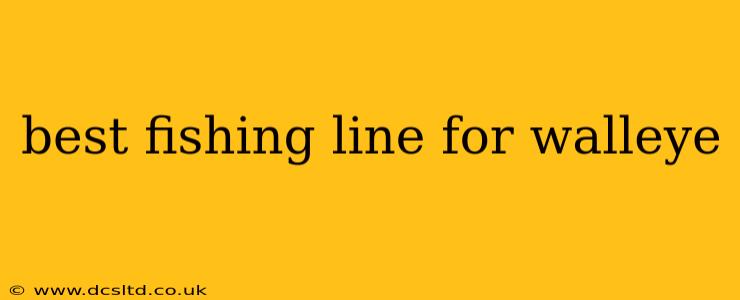Walleye fishing demands a line that balances strength, sensitivity, and low visibility. Choosing the right line can significantly impact your success rate, influencing your ability to feel subtle bites and make accurate casts. This guide explores the best fishing lines for walleye, covering various types and their ideal applications. We'll delve into the specifics to help you make an informed decision based on your fishing style and preferred techniques.
What Makes a Fishing Line Ideal for Walleye?
Before diving into specific line types, let's outline the key characteristics of a walleye fishing line:
- Sensitivity: Walleye bites can be subtle. A sensitive line allows you to detect even the slightest nibbles, giving you the opportunity to set the hook effectively.
- Strength: Walleye can put up a good fight, particularly larger specimens. Your line needs to be strong enough to handle the pressure without breaking.
- Abrasion Resistance: Fishing in rocky areas or around submerged structures requires a line that can withstand abrasion without easily fraying.
- Low Visibility: Walleye are visually sensitive. A low-visibility line helps to avoid spooking fish, increasing your chances of a successful hook-up.
- Stretch: A moderate amount of stretch is beneficial in absorbing shock during the fight, reducing the risk of line breakage. Too much stretch, however, can make detecting bites more challenging.
Types of Fishing Line for Walleye and Their Pros & Cons
Several types of fishing lines are suitable for walleye fishing, each with its own advantages and disadvantages:
1. Monofilament Line
- Pros: Affordable, relatively strong, good knot strength, available in various strengths and diameters, forgiving to beginners.
- Cons: Stretches more than other lines, less sensitive than braided line, can be more visible in clear water.
- Ideal for: Beginners, anglers fishing in moderately stained water, and situations where abrasion resistance isn't a primary concern.
2. Fluorocarbon Line
- Pros: Nearly invisible underwater, high abrasion resistance, low stretch, strong knot strength, sinks faster than monofilament.
- Cons: More expensive than monofilament, can be stiffer and less forgiving to beginners, slightly weaker knot strength than some other types.
- Ideal for: Clear water situations, anglers fishing around structure or vegetation, situations where stealth is paramount.
3. Braided Line
- Pros: Extremely strong for its diameter, virtually no stretch, highly sensitive, excellent for long casts.
- Cons: Can be more visible than fluorocarbon, can cut through your hands if not handled carefully, not as abrasion-resistant as fluorocarbon, can be more expensive.
- Ideal for: Anglers fishing in deep water, targeting large walleye, or situations where casting distance is crucial.
H2: What Line Test Should I Use for Walleye Fishing?
The appropriate line test depends on several factors, including the size of the walleye you're targeting, the type of tackle you're using, and the fishing conditions. Generally, a line test between 6 and 12 pounds is suitable for most walleye fishing situations. Lighter lines are better for smaller walleye and clearer water, while heavier lines are useful for larger fish and areas with more cover.
H2: What is the Best Knot for Walleye Fishing Line?
Several knots are excellent for walleye fishing, including the Palomar knot, the improved clinch knot, and the uni-knot. The Palomar knot is particularly popular due to its strength and ease of tying. Experiment with different knots to find what works best for you and your preferred line type.
H2: How Often Should I Replace My Walleye Fishing Line?
Replacing your fishing line regularly is crucial for maintaining its strength and preventing line breaks. The frequency of replacement depends on several factors, including how often you fish, the type of line used, and the conditions you fish in. As a general rule, inspect your line frequently for wear and tear. Replace it if you notice any fraying, nicks, or weakening.
Conclusion: Choosing Your Walleye Fishing Line
The "best" fishing line for walleye is highly dependent on your individual fishing style, preferences, and the specific conditions you face. By understanding the strengths and weaknesses of each line type and considering the factors discussed above, you can choose the line that will help you consistently land more walleye. Remember to always prioritize responsible fishing practices and respect the environment.
